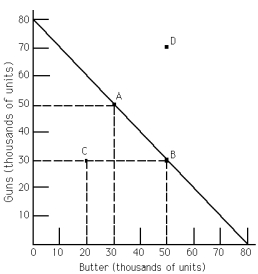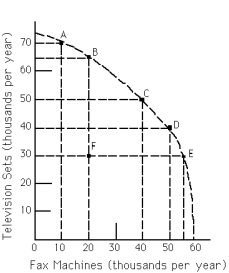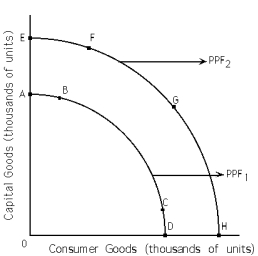A) Michael has the comparative advantage in producing X and Vernon has the comparative advantage in producing Y.
B) Michael has the comparative advantage in producing Y and Vernon has the comparative advantage in producing X.
C) Neither Michael nor Vernon has a comparative advantage in producing X.
D) Neither Michael nor Vernon has a comparative advantage in producing Y.
E) There is not enough information to answer the question.
G) A) and B)
Correct Answer

verified
Correct Answer
verified
Multiple Choice
Points inside (or below) the PPF are
A) unattainable.
B) attainable and productive efficient.
C) attainable but productive inefficient.
D) attainable and neither productive efficient nor productive inefficient.
F) A) and B)
Correct Answer

verified
Correct Answer
verified
True/False
When an economy is not using all of its resources,it is producing at a point below its production possibilities frontier.
B) False
Correct Answer

verified
Correct Answer
verified
Multiple Choice
The economy can produce 15X and 15Y,10X and 20Y,5X and 25Y,or OX and 30Y.It follows that the production possibility frontier (PPF) is
A) a downward-sloping straight line.
B) an upward-sloping straight line.
C) a downward-sloping convex curve.
D) a downward-sloping concave curve.
F) A) and C)
Correct Answer

verified
Correct Answer
verified
True/False
In a PPF graph of goods X and Y,points that lie beyond (to the right of)the PPF represent combinations of the two goods that are currently unattainable.
B) False
Correct Answer

verified
Correct Answer
verified
True/False
If the PPF for two goods is a downward-sloping straight line,the resources used to produce those goods are equally well suited to the production of both goods.
B) False
Correct Answer

verified
Correct Answer
verified
Multiple Choice
Exhibit 2-1  -Refer to Exhibit 2-1.Scarcity exists
-Refer to Exhibit 2-1.Scarcity exists
A) at point C but not at point A.
B) neither at point C nor at point A.
C) at both point C and at point A.
D) at point A but not at point C.
F) A) and D)
Correct Answer

verified
Correct Answer
verified
Multiple Choice
Exhibit 2-5  -Refer to Exhibit 2-5.The opportunity cost of moving from point D to point C is
-Refer to Exhibit 2-5.The opportunity cost of moving from point D to point C is
A) 5,000 televisions.
B) 5,000 fax machines.
C) 10,000 televisions.
D) 10,000 fax machines.
F) A) and D)
Correct Answer

verified
Correct Answer
verified
Multiple Choice
Suppose Andrea is taking just two courses and is at a point on her PPF of grades for those two courses.Now this PPF shifts inward and Andrea moves to a point on the new PPF.Then it is impossible for
A) both of her grades to fall.
B) both of her grades to rise.
C) one of her grades to rise and the other grade to fall.
D) one of her grades to fall while the other grade stays constant.
F) All of the above
Correct Answer

verified
Correct Answer
verified
Multiple Choice
Within the production possibilities frontier (PPF) framework,choice is depicted by the
A) PPF itself.
B) PPF being bowed outward.
C) need to select among the points making up the PPF.
D) straight-line PPF.
F) B) and C)
Correct Answer

verified
Correct Answer
verified
Multiple Choice
Points outside (or beyond) the PPF are
A) attainable.
B) unattainable.
C) efficient.
D) inefficient.
F) All of the above
Correct Answer

verified
Correct Answer
verified
Multiple Choice
Productive efficiency implies
A) the possibility of gains in one area without losses in another.
B) that more output has been produced.
C) the impossibility of gains in one area without losses in another.
D) that prices are stable.
E) c and d
G) A) and E)
Correct Answer

verified
Correct Answer
verified
Multiple Choice
Suppose the economy goes from a point on its production possibilities frontier (PPF) to a point below that PPF.Assuming that the PPF has not shifted,this could be due to
A) a gain of resources.
B) a loss of resources.
C) technological improvement in the production of both goods.
D) a new law that interferes with economic efficiency.
F) B) and C)
Correct Answer

verified
Correct Answer
verified
Multiple Choice
Exhibit 2-1  -Refer to Exhibit 2-1.The opportunity cost of moving from point A to B is
-Refer to Exhibit 2-1.The opportunity cost of moving from point A to B is
A) 10,000 units of butter.
B) 20,000 units of butter.
C) 20,000 units of guns.
D) 10,000 units of guns.
F) A) and B)
Correct Answer

verified
Correct Answer
verified
Multiple Choice
Exhibit 2-9
 -Refer to Exhibit 2-9.If Alex and Adam each specialize in the good in which he has a comparative advantage and then engage in trade,____________________ can consume a combination of goods that lies beyond his PPF.
-Refer to Exhibit 2-9.If Alex and Adam each specialize in the good in which he has a comparative advantage and then engage in trade,____________________ can consume a combination of goods that lies beyond his PPF.
A) Alex,but not Adam,
B) Adam,but not Alex
C) Alex and Adam
D) neither Alex nor Adam
F) A) and B)
Correct Answer

verified
Correct Answer
verified
Multiple Choice
Exhibit 2-3  -Refer to Exhibit 2-3.If PPF1 is the relevant production possibilities frontier,society may move to PPF2 as a result of
-Refer to Exhibit 2-3.If PPF1 is the relevant production possibilities frontier,society may move to PPF2 as a result of
A) an increase in resources.
B) a decrease in resources.
C) an increase in technology.
D) both a and c
E) both b and c
G) B) and E)
Correct Answer

verified
Correct Answer
verified
Multiple Choice
If the law of increasing opportunity costs is operable,and currently the opportunity cost of producing the 1,000th unit of good X is 0.5Y,then the opportunity cost of producing the 2,001st unit of good is X is most likely to be
A) less than 0.5Y.
B) more than 0.5Y but less than 2Y.
C) more than 0.5Y
D) less than 0.5Y but more than zero.
E) none of the above
G) A) and C)
Correct Answer

verified
Correct Answer
verified
Multiple Choice
The increased production of lamps comes at constant opportunity costs in terms of bookshelves.This means
A) that it takes more resources to produce a lamp than a bookshelf.
B) that it takes fewer resources to produce a lamp than a bookshelf.
C) that for every lamp produced,a constant number of bookshelves is forfeited.
D) that for every lamp produced,a different number of bookshelves is forfeited.
F) All of the above
Correct Answer

verified
Correct Answer
verified
Multiple Choice
If resources are better suited toward the production of one good than toward the other good,then the PPF for those two goods is
A) a straight line.
B) bowed outward.
C) upward sloping.
D) any of the above
F) None of the above
Correct Answer

verified
Correct Answer
verified
Multiple Choice
Both country 1 and country 2 are located on their respective production possibilities frontiers (PPFs) ,but country 1 produces twice the output that country 2 produces.It follows that
A) country 1's PPF lies further to the right than country 2's PPF.
B) country 1 has a smaller population than country 2.
C) country 1 has a bigger population than country 2.
D) country 1 is efficient and country 2 is inefficient.
E) none of the above
G) None of the above
Correct Answer

verified
Correct Answer
verified
Showing 81 - 100 of 149
Related Exams